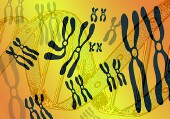
WEDNESDAY, Aug. 10 (HealthDay News) — Some of the genetic variants implicated in ADHD (attention-deficit/hyperactivity disorder) overlap with genes and nerve communication pathways that play a role in autism, a new study finds.
The research may help to explain why people with ADHD, autism and other neuropsychiatric disorders sometimes have symptoms in common, such as impulsivity and restlessness, researchers said.
Instead of finding one or more “ADHD” or “autism” genes, research is beginning to uncover neural pathways that influence the way a brain develops and works, said senior study author Dr. Russell Schachar, a senior scientist and child psychiatrist at the Hospital for Sick Children in Toronto.
“What we are beginning to understand is that genes don’t code for disorders as they appear in the diagnostic manual. Genes code for proteins that are needed for brain structure and brain function,” Schachar said. “Many of the genes we discovered involved in both ADHD and [autism spectrum disorders] affect the development of the nervous system.”
The study appears in the Aug. 10 issue of Science Translational Medicine.
ADHD is marked by difficulty paying attention, hyperactivity and impulsiveness. While it’s known that ADHD has a strong genetic component, researchers have had limited success identifying specific genes or neural pathways that can explain it, the study authors said.
In the study, researchers analyzed the DNA of 248 children with ADHD, along with many of their parents. They found that about 9.4 percent of kids with ADHD (or about one in 10) had identifiable abnormalities known as copy number variations, which are changes in the DNA that cause an abnormal number of copies of one or more genes.
This means that on certain chromosomes, bits of DNA were deleted or duplicated. The copy number variations were on genes expressed, or active, in the brain.
Of those children with detectable copy number variations, about 7.7 percent were inherited from the parents, while about 1.7 percent were “de novo,” or new, variants, meaning the parents didn’t have the abnormalities.
To look for overlap between ADHD and autism spectrum disorders (ASD), researchers also looked for copy number variants on 349 people with autism.
About 25 percent of the kids with ADHD had copy number variants that also showed up in the autism sample, although for about three-fourths, the copy number variants were “unique to ADHD,” Schachar said.
Analyzed the other way around, researchers also found that a small percentage of ASD kids had copy number variants that showed up in the ADHD kids.
Overall, in four autism patients and two ADHD patients, the researchers discovered a cluster of rare copy number variations on chromosome 9 and around several genes necessary for the nervous system and brain development in mammals.
The same region on chromosome 9 is also thought to include copy number variations associated with bipolar disorder, intellectual disability and schizophrenia.
Dr. Andrew Adesman, chief of developmental and behavioral pediatrics at the Steven and Alexandra Cohen Children’s Medical Center of New York, said parents shouldn’t read the study to mean that kids with autism and ADHD necessarily have anything in common genetically.
“The study is reporting, using very sophisticated molecular genetic techniques, that a small percentage of children with ADHD have an identifiable, rare copy number variant, or a deletion or duplication of part of a gene,” Adesman said.
Yet the study was only able to identify a copy number variation in one in 10 kids, which means for the other 90 percent, nothing abnormal showed up on the genetic test.
And then from that group, it was only a minority that shared a variant with the ASD kids and vice versa. “The vast majority of kids with both ASD or ADHD have none of these copy number variations in common,” he said.
Even so, the study adds to the understanding of some of the genetic underpinnings of each disorder, he said.
Physicians who treat kids with ADHD and autism say the findings that there can be shared genetic risk underlying both conditions isn’t surprising.
“It is very common for a child with autism, or ASD, to present with restlessness, inattention and impulsiveness, so much so that they merit a secondary diagnosis of ADHD, and they sometimes are treated with ADHD [medications] such as stimulants,” Schachar said. “And some kids who come to clinics with ADHD have a lot of problems with social interactions, social understanding, and occasionally some of them are thought to be ‘spectrumy.'”
But much remains unknown, including what else happens, either genetically or environmentally, that leads one child to develop ADHD and another to develop ASD.
More information
Children and Adults with Attention Deficit/Hyperactivity Disorder (CHADD) has more on ADHD.

